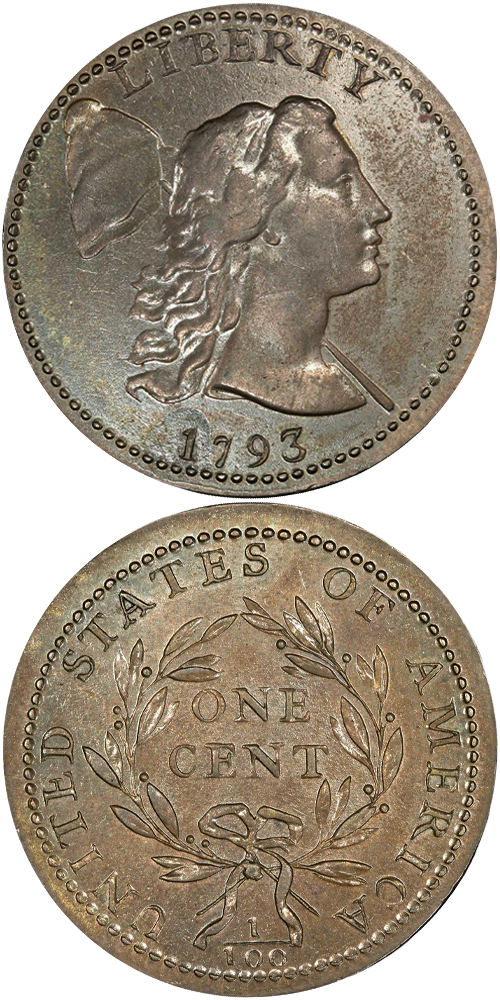1793 Liberty Cap Cent
As a young portrait painter studying in London, just 26 years old, Joseph Wright was dispatched to Paris to paint Benjamin Franklin. He spent much of the first half of 1782 in Passy, the Paris suburb that served as Franklin's home in France. In March 1782, Franklin conceived a medal that would have an enormous impact on the future of American coinage and the numismatic legacy of Joseph Wright. On March 4 of that year Franklin wrote to Robert R. Livingston, who had served with Franklin on the committee to compose the Declaration of Independence: "This puts me in a mind of a medal I have had a mind to strike, since the late great event you gave me an account of, representing the United States." A year later, Franklin's brainchild would be realized, and the Libertas Americana medal engraved by Augustin Dupre would become a sensation in Europe and America. Joseph Wright left Paris while the medal was still in its design stages, but its impact on his later works is clear. His Liberty Cap cent of 1793, the first of which were struck just a day before the 1793 half cents that displayed a similar design, copied the obverse of the Libertas Americana medal almost exactly. Franklin's official explication or description of the medal, published in Paris in May 1783, describes the obverse portrait: "the head representing American Liberty has its tresses floating in the air, to show that she is in activity. The cap carried on a spear is her ensign." The cap, of course, is the Liberty cap, a stylized version of the pileus of classical times, a powerful symbol of freedom that was commonplace in England and America even before the American Revolution.
Many, perhaps most, of the leaders of the American Revolution were given examples of the Libertas Americana medal. Jefferson's was displayed in a frame at Monticello and described in his inventory of art as "a medal by Doctor Franklin." Washington's, struck in silver, was housed in a sumptuous box that contained a set of medals struck in France to commemorate the Revolution. If Wright didn't own one personally, the odds are good that others in his circle did, likely including Mint Director David Rittenhouse.
Joseph Wright's relationship to the United States Mint began even before coining did. He is known to have produced two works before his final project, the 1793 Liberty Cap cent. Their sequence is not known. Wright's 1792 "Eagle on Globe" pattern was almost certainly produced as an essay for the quarter dollar denomination, an extreme rarity today though examples are known in both copper and white metal. His medal for Henry Lee was the last entry into the Comitia American medal series, composed of medals authorized by Congress to be presented to military leaders of the Revolution. While all others were engraved and struck in Paris in the 1780s, the Lee medal was somehow neglected. The obverse for Wright's portrait medal of Lee cracked in hardening, and strikes from his original dies are so rare today as to be entirely uncollectible. Both of these efforts preceded his 1793 Liberty Cap cent, of which four obverses and two reverses were produced.
Research by Bill Eckberg, published in Penny-Wise in September 2010, has shown that the 1793 Liberty Cap cents were struck on July 18 and July 22, indicating that the dies must have been executed some time earlier. The fruits of the Mint's labor for those two days amounted to 11,056 cents, representing the sum total of the 1793 Liberty Cap cent production, all delivered to the Mint's treasurer on September 18. By the day they were inspected, counted, and turned over for distribution, Joseph Wright was dead, a victim of the plague that turned Philadelphia vacant during the late summer doldrums for years into the early 19th century: yellow fever.
Among Wright's last acts was to lodge a request with the United States government that his estate be paid for his two projects before his official employment as a Mint engraver. Mordecai Wetherill (mistranscribed in Taxay as "Moid Wetherill") was the son of Samuel Wetherill, a druggist who served as chairman of the Yellow Fever Committee of the Common Council of the city of Philadelphia in 1793. On September 11, 1793, when Wright was just a day or two from death, Wetherill was dispatched with a memo from Wright:
Joseph Wright being very ill and not expecting to recover, requested the subscriber to make a memorandum as follows: that the said Joseph Wright had presented an account against the United States for cutting a medal, amount fifty guineas. Two essays of a quarter dollar, cut by direction of David Rittenhouse, Esqr. and presented to him (broke in hardening) value about 40 guineas.
On December 31, 1793, Thomas Jefferson closed the book on Joseph Wright's career with the Mint officially, issuing an order that asked for "Wright's representatives to be paid for engraving the medal of Govr Lee and (that being broke in hardening) another to be engraved." Yet, his artistic concept of Liberty lived on. The Liberty Cap design persisted on cents through 1796 (and most other denominations, sans cap), when the French association with the Libertas Americana apparently became too politically poisonous for the design to continue.
The example to the left was sold by Stack's Bowers Galleries in the D. Brent Pogue Part V Auction, where it realized $940,000.






